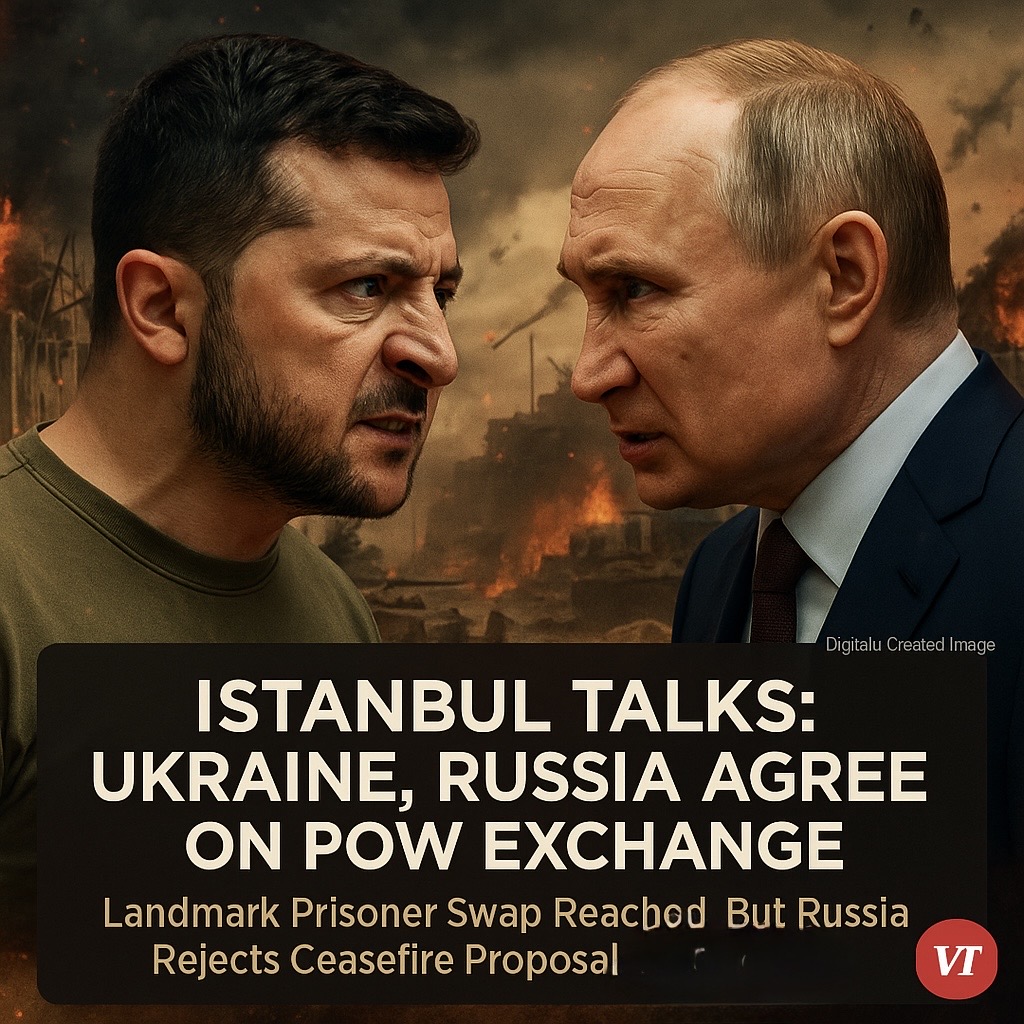- Ukraine and Russia agree to an “all-for-all” POW exchange and 6,000-for-6,000 remains repatriation.
- Ukraine’s 30-day ceasefire proposal rejected by Russia; talks labeled as symbolic by Kyiv.
- Ukraine launched a major drone strike on June 1, damaging over 40 Russian aircraft before the talks.
- NATO and EU back Ukraine’s peace formula; leaders’ summit proposed for late June.
- Background: The conflict began in 2014 and escalated into full-scale war in February 2022.
ISTANBUL — The June 2 peace talks between Ukraine and Russia in Istanbul ended with a significant humanitarian agreement but exposed widening rifts over ceasefire conditions. While both sides agreed to a major prisoner and remains exchange, Ukrainian officials say Russia’s rejection of an unconditional ceasefire demonstrates a continued lack of seriousness. The meeting came just one day after Ukraine launched one of its most extensive drone operations inside Russia — a signal that military action continues even amid negotiations.
Ceasefire Proposal Rejected by Russia
During the Istanbul meeting, Ukrainian Defense Minister Rustem Umerov presented a formal proposal for a 30-day unconditional ceasefire. Russia declined the offer, instead suggesting a limited 2–3 day truce in select areas to recover fallen soldiers. Kyiv characterized the Russian response as “performative” and lacking commitment to real de-escalation.
Umerov stated that Ukraine had submitted its ceasefire documents in advance, but Russia delivered its counterproposal only during the meeting. His remarks were published on his official X account.
Landmark POW and Remains Exchange Agreement
Despite the ceasefire impasse, both sides finalized a significant humanitarian exchange agreement. According to Ukrainian government and intelligence agencies, the deal includes:
- All seriously wounded and critically ill POWs
- All soldiers aged 18–25
- 6,000-for-6,000 remains exchange of fallen soldiers
- A verified list of 339 abducted Ukrainian children was submitted to Russia; only 10 were acknowledged
The deal was confirmed via public statements from the Coordination Headquarters for the Treatment of Prisoners of War.
NATO, EU, and Allies Maintain Pressure
Following the Istanbul talks, President Zelenskyy met with NATO Secretary-General Mark Rutte. NATO reaffirmed long-range weapons support and confirmed Ukraine’s formal participation at the upcoming NATO Summit in The Hague. The European Union emphasized that any peace process must involve a full Russian withdrawal and restoration of Ukraine’s territorial integrity.
Meanwhile, earlier last week, U.S. President Donald Trump gave Russian President Vladimir Putin a two-week deadline to demonstrate seriousness in peace negotiations or face broader consequences.
Leader-Level Summit Proposed for June
Ukraine has proposed a direct summit between President Zelenskyy and President Putin to be held between June 20–30, with Turkey offering to host. Ukrainian officials say if Russia fails to engage seriously, international sanctions and diplomatic isolation must escalate.
While the prisoner exchange marks rare progress, Ukrainian leaders warn that peace cannot be achieved on Russia’s terms — and that continued military strength and global unity are essential to end the war.
Ukraine’s Massive Drone Strike on Russian Airfields
Just one day before the Istanbul meeting, on June 1, Ukrainian forces launched “Operation Spider’s Web,” one of the most sophisticated drone strikes since the war began. Ukrainian defense sources say 117 drones were deployed in waves, hitting multiple Russian airbases and reportedly damaging or destroying more than 40 aircraft, including Tu-95 and Tu-22M3 bombers and A-50 radar planes.
The drones were reportedly smuggled into Russia in cargo trucks months in advance. The operation, planned over 18 months, demonstrated Ukraine’s ability to strike deep into Russian territory and revealed major vulnerabilities in Russia’s air defense infrastructure.
Background: The Ukraine–Russia Conflict and Full-Scale War
Tensions between Ukraine and Russia date back to 2014, when Russia annexed Crimea following the Euromaidan revolution. This move triggered an eight-year conflict in the Donbas region, where Russian-backed separatists and Ukrainian forces fought over control. Despite international condemnation and sanctions, Russia continued to escalate involvement in Ukraine’s eastern regions.
On February 24, 2022, Russia launched a full-scale invasion, targeting Kyiv, Kharkiv, Mariupol, and other major cities. Ukrainian resistance, bolstered by Western support, pushed Russian forces out of parts of the north and south. However, large areas of Donetsk, Luhansk, and southern territories remain under Russian occupation. The war has since become the largest conflict in Europe since World War II, with widespread destruction, economic shocks, and millions of refugees.
(With verified statements from Defense Minister Rustem Umerov, the Coordination Headquarters for the Treatment of Prisoners of War, and official Ukrainian defense briefings.)
A global media for the latest news, entertainment, music fashion, and more.















